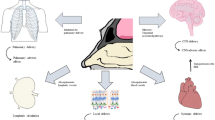Abstract
Anin vitro human nasal model was developed as a tool to study the local tolerabiliity of nasal powder forms using excised nasal mucosa in a diffusion chamber. The suitability of this model was tested using Sandostatin® (SMS) an octapeptide analog of somatostatin, as a reference drug enhanced by Avicel® (microcrystalline cellulose) or lactose (100 mesh). The standard nasal spray vehicle was taken as a harmless control and 1% chenodeoxycholate (CDC) as a harmful control in terms of local tolerability. The extent of peptide permeation was determined by measuring SMS concentration in the receiving chamber. The labeling of SMS was detected by immunoperoxidase staining on cross sections. The local tolerability for all tested forms was assessed by histopathological examination and scanning electron microscopy. The apparent permeation coefficient allowed us to rank the absorption of the tested drug forms as Avicel > spray=lactose>1%CDC. For all formulations, SMS was detected in the epithelium. No changes of the nasal mucosa could be observed with Avicel, lactose or nasal spray vehicle in the presence or absence of SMS. 1%CDC with or without drug showed an immediate destruction of the nasal epithelium. The validation of thisin vitro model using human nasal mucosa will be further discussed as a tool for assessing the local tolerability of intranasally applied test substances.
Similar content being viewed by others
Abbreviations
- CDC:
-
chenodeoxycholate
- SMS:
-
Sandostatin® or octreotide
References
Ainge G, Bowles JAK, McCormick SG, Richards DH, Scales MDC. Lack of deleterious effects of corticosteroid sprays containing benzalkonium chloride on nasal ciliated epithelium. In vivo results in laboratory animals. Drug Invest. 1994;8:127–33.
Audus K, Bartel RL, Hidalgo IJ, Borchardt RT. The use of cultured epithelial and endothelial cells for drug transport and metabolism studies. Pharm Res. 1990;7:435–51.
Björk E, Edman P. Characterization of degradable starch microspheres as a nasal delivery system for drugs. Int J Pharm. 1990;62:187–92.
Donovan MD, Flynn GL, Amidon GL. The molecular weight dependence of nasal absorption: the effect of absorption enhancers. Pharm Res. 1990;7:808–15.
Drewe J, Fricker G, Vonderscher J, Beglinger C. Enteral absorption of octreotide absorption enhancement by polyoxyethylene-24-cholesterol ether. Br J Pharmacol. 1993;108:298–303.
Edman P, Björk E, Ryden L. Microspheres as a nasal delivery system for peptide drugs. J Controlled Release. 1992;21: 165–72.
Ezzat S, Snyder PJ, Young WF et al. Octreotide treatment of acromegaly. Ann Intern Med. 1992;117:711–8.
Fricker G, Bruns C, Munzer J et al. Intestinal absorption of the octapeptide SMS 201-995 visualized by fluorescence derivatization. Gastroenterology. 1991;100:1544–52.
Harris AG, Weeke J, Christensen SE, Kaal A, Illum P, Orskov H. Preliminary results with Sandostatin nasal powder in acromegalic patients. Metab Clin Exp. 1992;41:72–5.
Holmberg K, Bjork E, Bake B, Edman P. Influence of degradable starch microspheres on the human nasal mucosa. Rhinology. 1994;32:74–7.
Illum L, Jorgensen H, Bisgaard H, Krogsgaard O, Rossing N. Bioadhesive microspheres as a potential nasal drug delivery system. Int J Pharm. 1987;39:189–99.
Kissel T, Drewe J, Bantle S, Rummelt A, Beglinger C. Tolerability and absorption enhancement of intranasally administrated octreotide by sodium taurodihydrofusidate in healthy subjects. Pharm Res. 1992;9:52–7.
Kocak S, Bumin C, Karayalcin K, Alacayir I, Aribal D. Treatment of external biliary, pancreatic and intestinal fistulas with a somatostatin analog. Dig Dis. 1994;12:62–8.
Kouromalis EA, Skordilis P, Liapakis G, Thermos K, Manousos ON. Treatment of hepatocellular carcinomas with somatostatin. Gut. 1994;35:S72.
Shyu WC, Mayol RF, Pfeffer M, Pittman KA, Gammans RE, Barbhaiya R. Biopharmaceutical evaluation of transnasal, sublingual, and buccal disk dosage forms of butorphanol. Biopharm Drug Disposition. 1993;14:371–9.
Su KSE, Campanale KM, Mendelsohn LG, Kerchner GA, Gries CL. Nasal delivery of polypeptides I: nasal absorption of enkephalins in rats. J Pharm Sci. 1985;74:394–8.
Weeke J, Christensen SE, Orskov H et al. A randomized comparison of intranasal and injectable octreotide administration in patients with acromegaly. J Clin Endocrinol Metab. 1992;75:163–9.
Yamamoto A, Morita T, Hashida M, Sezaki H. Effect of absorption promoters on the nasal absorption of drugs with various molecular weights. Int J Pharm. 1993;93:91–9.
Author information
Authors and Affiliations
Rights and permissions
About this article
Cite this article
de Fraissinette, A., Kolopp, M., Schiller, I. et al. In vitro tolerability of human nasal mucosa: histopathological and scanning electron-microscopic evaluation of nasal forms containing Sandostatin® . Cell Biol Toxicol 11, 295–301 (1995). https://doi.org/10.1007/BF00757627
Accepted:
Issue Date:
DOI: https://doi.org/10.1007/BF00757627




